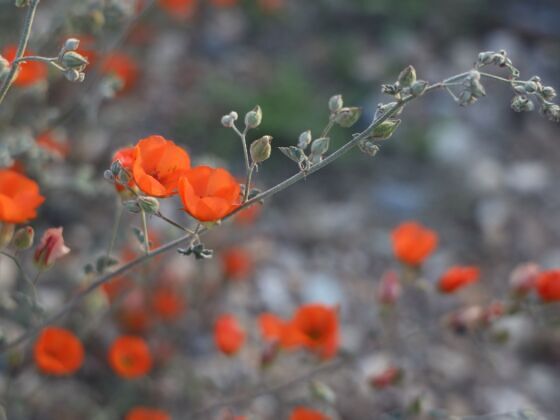I FINISH MY READING at a Southwestern Writers’ Conference. I have spoken about crippling pain from a hiking fall and seeing a dust cloud from the Gobi Desert turn the sun moon-silver over the Black Rock, and how a volcanic out-cropping seen against sunset can become figures from a Javanese shadow play. A woman in the audience stands. “Could you please tell us,” she says, “your writing process?”


I abhor the word “process” almost as much as I do the word “issues,” but her eyes have that “I gotta know the secret” look, so I soften my voice and say, “Which one?”
Here is one of the ways It works when It works:
At the intersection of a dirt road and wash near Horse Tanks in the Kofa, a man once told my friend and me that he had just walked a 10-mile loop in search of a Ghost Flower, and had found two. My friend asked him if he was a botanist.
“Not a trained botanist,” the guy said. “I’d say I was a para-botanist, but there is only one of me.”
His joke had made perfect sense to me. I’d spent days chasing a ghost in my mind, a ghost I had begun to suspect was, as the Buddhhists say, gate, gate, paragate — gone, gone, gone to the other shore.
We three talked in the heart of pure corporeal. Everything was in bloom, globe mallow an orange lantern at sunset; magenta prickly pear blossoms, as many as five on a cactus paddle; desert lavender, smelling of sage and lavender; scarlet flowers whose names I didn’t know, and a tiny white one, no bigger than a sequin, growing alone from a rock.
Less than 30 minutes from our meeting with the man who found the Ghost Flowers, I couldn’t see globe mallow, prickly pear, or the last shimmer of sunset. I was deep in my mind, deep in conversation with the ghost gone over. I set my foot on a small boulder. It rolled backwards. I was thrown forward to the ground.
For six months, pain hollowed me out. I became a ghost. Slowly, far more slowly than the desert blossoms after rain, I reoccupied my shell. I made myself feel hope by remembering that somewhere in a 10-mile loop of dirt road in the Kofa, two Ghost Flowers might someday bloom again and I might move again over the desert to find them.
And now, 11 months later, I sit on red sandstone. I look down at a pool in Red Tank Draw in the Verde Valley. I open my journal and write:
The sun is a platinum disc trapped in a web of dark branches on the surface of the water. A breeze moves over us. Sun and water-trees shudder. I remember looking down into what had once been an arm of Glen Canyon and seeing five feet below our boat, the tangled branches of drowned cottonwoods.
Here, the small wind is steady. The sun’s halo trembles. Clouds soften what lies above. What lies mirrored on the water, a platinum disc webbed in black and haloed by vaporous blue, pink and green, might be the mouth of a passageway that leads into a diamond lens.
I work a spell. I am worked by what contains me. The clouds pass over. Sun is warm on my face.
The rocks underwater are fuzzy with algae. For at least a century, cows have shit upstream. Transformation is not always glorious.
Another friend walks toward me. He is a carpenter and wood carver. He watches the world for how it is put together, for connections, where they might fracture, where they might hold. He has walked west, along the creek. He tells me the water disappears, then returns. There is a series of pools. “And this,” he says, “what is this?”
He holds up a stalk. It rises through the middle of an arrow-head shaped leaf. There are tiny dried seed husks springing from the top of the stem. The leaf is mottled green and wine-red, the seed husk cinnabar.
“I don’t know what it is,” I say. “I’ve seen it before. I’ll find out.”
I think of my friends Ilse, the wild-crafter, and Phyllis, the ethno-botanist. I think of the internet — of human and digital networks of knowledge.
“There are new plants coming up around the dried stalks,” my friend says. “They are green and much smaller, but the stem comes right through the center of the leaf the same way.”
Later, we climb out of the wash. My feet are steady on rock and talus. I imagine joy coursing through my veins.
The flower that is not a ghost draws me further, on trails and currents that move over other than sand or rivers. I enter my computer and follow cairns and bubble-lines. I find a photo of a living flower with a leaf-clasped stem; I extrapolate from its vibrant green and pink to the dry stalk that stands next to my kitchen statue of Guadalupe. The website contains a phone number.
I make a call. When I come back from walking, there is a message on my cell phone. “The plant on the website is Penstemon pseudospectabalis.” It occurs to me the name is a joke, an echo of the days when surfer girls pronounced everything totally fantabulous! I google Penstemon pseudospectabalis and find a galaxy of photos — a hundred Penstemon p., all clasped by a single leaf, all bearing sprays of blossoms like magenta comets.
The map of my world grows more complete; it will never be finished. It is shaped by para-botanists and carpenters, by damage and time and what we see when we hunt connections. It is the map of impossibility, the map of What Is.
It is the map of How to Write.